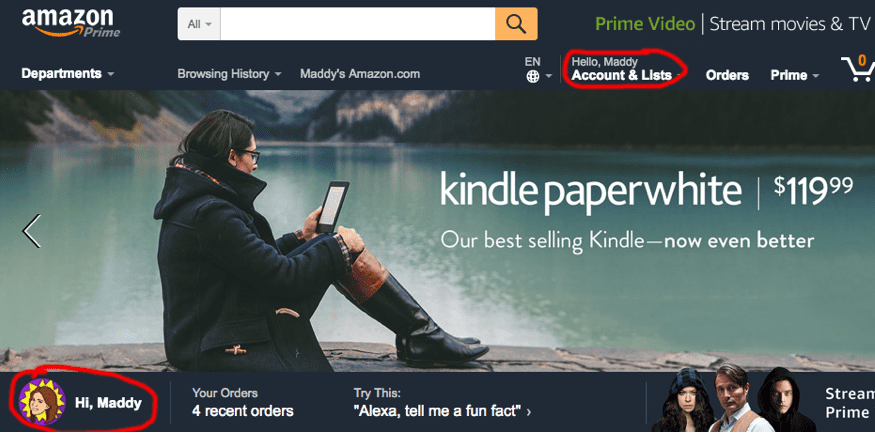Boost your conversion rate with ecommerce personalisation
When it comes to giving customers a better shopping experience it is crucial to make them feel like they are valued. In a brick and mortar store, this can be done through personal greetings, in-store perks, and personalized offers based on feedback that results from in-store conversations.
Running an ecommerce business presents an additional layer of challenges for businesses trying to nurture personal relationships with customers. But these challenges are not insurmountable when using ecommerce personalization for better conversions.
What is Ecommerce Personalization?
Ecommerce personalization involves giving customers a customized shopping experience based on their demographics, likes and dislikes, tastes, previous purchases, interests, and buying behavior.
Ecommerce personalization for better conversions has proven itself to be a great investment both qualitatively and quantitatively. Jeff Bezos, CEO of Amazon has been quoted saying, “If you do build a great experience, customers tell each other about that. Word of mouth is very powerful.” Furthermore, the data (courtesy of Infosys) behind ecommerce personalization speaks for itself:
- 59% of shoppers say that personalization influences their shopping decisions
- 31% of customers would like their shopping experience to be more personalized than it actually is
- 74% of customers feel frustrated when website content is not personalized
According to research by Gartner, B2B companies with effective personalization on their ecommerce sites will outsell competitors without the same level of personalization by 30 percent by 2018.
3 Types of Ecommerce Personalization
There are a number of different types of ecommerce personalization, with new tactics being constantly developed. Here are the three main strategies for ecommerce Personalization to consider for your online business with regards to creating conversions.
1. Content/Channel Personalization
Once you have a decent understanding of your customer’s behavior, or at least some basic data to work off, you should start to personalize content. Personalization can occur in email newsletters, ads, website content, social media, push notifications and promotions. All channels used to communicate with the customers should be personalized.
One tactic for personalizing content is real time offers. This can take the form of coupons or promotions that can be personalized through behavior patterns, like how often a person visits the site, for how long, and whether this person was referred by another website. In the latter case, it might make sense to offer a different type of coupon for the customer to make their first purchase. For returning customers, instead offer coupons for loyalty. Having access to this data and an automated mechanism for promotion delivery makes this process infinitely easier than trying to manually send relevant coupons to customers.
Behavior personalization is part of content/channel personalization, and can be broken up into customer behavior and rule-based personalization.
Customer Behavior
This personalization method involves studying customer behavior according to the different market segments they belong to. You can hire a third party to do this, or do it yourself using Personalization Software.
With the first option, you can customize ecommerce properties first by buying data about a particular consumer group from a third party data provider. Before deciding on a third-party from which to purchase data, make sure to have a strategy in place to measure results, and pick a data provider that has a lot of trust in the industry in which you operate. This data is usually used in targeted ads.
On your own, you can use customer segmentation to divide your list into distinct user groups, based on their behaviors. From those groups, you can then develop a market persona that can serve as a template for how customers behave and how they will react towards promotions, and other ecommerce efforts. If you’re not sure where to start, here are a few ideas for segmenting data.
To summarize, customer behavior Personalization is based on marketing personas.
Rule-based Personalization
Once you have defined the customer profile through his behavior (both his buyer persona and how he navigates the website), the marketing team can determine what actions to undertake after the user takes a certain action. In short, the marketing team directs the flow of activity based on the information gleaned. They determine who gets which email send, and who will get a certain promotion.
Think “if this, then that.” For example, if a user is searching for beach getaways on a travel site, the first thing that person should see when clicking through to the website is an assortment of beach getaways.
2. Offer/Benefit Personalization
To take the personalization a notch higher, consider personalizing on a more individual basis (versus personalization that looks at general customer behavior). For example, if a male visitor views products for a toddler, it is likely that he is a dad. A recommendation engine with artificial intelligence technology works real-time at the background, starts personalizing recommendations and offering products for toddlers to this visitor whereas it can recommend automotive parts for a male visitor who shows interest in cars. Another example can be, recommending a van, family car to the first profile and offering a sports car to the latter. Personalizing according to behavior, interests and other traits that are detected as digital finger prints can bring higher conversions.
Based on this, you can make promotional discounts for products relevant to your visitors seamlessly. This works because:
- It personalizes suggestions based on items they frequently look at
- A discount on the items they want to buy will give them the extra nudge to convert.
You can mix data for more personalization and subsequently, conversion. For example, try combining behavior and the day of the week, or day of the week and categories. Studies have found that Mondays are when people online shop the most & because of that, retail stores have the best deals on Mondays, too. Wednesdays have also been shown to have higher conversion rates based on email marketing newsletters sent. So on Mondays and Wednesdays, your ecommerce store might offer a coupon targeted to your customer segments. Ultimately, you’ll have to run your own tests to determine what personalization elements convert best when combined.
Another tactic for delivering personalized content is subject line personalization. This is perhaps the easiest ecommerce personalization tactic to take advantage of, thanks to easily implemented email marketing software settings. Emails with personalized subject lines are 26% more likely to be opened than non-personalized emails.
Using data, ecommerce personalization is possible through contextual messages. This means tailoring messages (usually ads) to consumers based on location, behavior, previous searches or devices.
Finally, try testing out dynamic remarketing. This ecommerce personalization tactic refers to ads that pop up when a shopper visits other websites, showing products that they’ve looked at previously. The point of these ads is to tempt you to come back and buy, and they’re incredibly effective. In fact, both BeBe and Mazda saw high conversion rates (71% and 53%, respectively) when implementing this tactic.
3. Personalized Layouts/Presentation/Web Pages
After determining behavior personas and creating audience segments, you can personalize website or page elements based on the visitors profile.
Navigational personalization is a tactic that looks at browser behavior and purchase history to make recommendations. Navigational behavior can be interpreted by digital body language, which is how visitors interact on your website, and a digital fingerprint, which is how a person got to the website (including keywords and websites referred).
To take advantage of navigational personalization, use tactics such as recommendation engines, which show users recommended products based on previous purchases, or items they have recently browsed. This ecommerce personalization effort can be implemented on the website itself, or through email campaigns. A study by MyBuys showed a 915% overall site conversion rate based on implementing recommended products.
Amazon uses this tactic often. In fact, most of their sales come from recommendations and other ecommerce personalization elements. It starts with a personalized page ([your name here]’s Amazon), then there’s the wishlist function, and even takes into consideration your location as far as available shopping options. Amazon also provides a history of products you’ve looked at, which can be useful when making comparisons, or even just revisiting an old purchase idea.
Ecommerce Personalization on Amazon

Another element of navigational personalization is user ID tracking. User ID tracking allows you to track consumer behavior across all of their (known) devices. When you have this data, you can more easily steer shoppers toward the specific products you want them to view.
Combining user ID tracking and recommendations leads to a higher level of personalization. And more Personalization means zeroing in on the exact right audience for a higher conversion rate.
To summarize, navigational behavior Personalization is completely based on browser behavior.
Measuring Ecommerce Personalization Efforts
After working on your personalization strategy, you’ll want to be able to measure its effectiveness in terms of conversions and ROI. If you haven’t already installed Google Analytics tracking code on your website, take the opportunity to do so before attempting a new personalization strategy. There are many different ways to use Google Analytics to track and increase ecommerce conversions. Get even more granular with the use of Segmentify’s Analytics Tools. Bannerify and Trendify measure banner and product performance, respectively.
Ecommerce Personalization for Better Conversions
Ecommerce personalization can make your customers feel special, which results in more conversions and sales. It’s important to note that Personalization efforts do not have to be blatant; they can be more inconspicuously implemented through targeted content and even site navigation. But before attempting advanced ecommerce personalization efforts, it’s important to first understand your consumer’s behavior so that any time and monetary investments don't go to waste.

Murat is the Co-Founder of
Segmentify, a SaaS tool providing conversion optimization services tailored for e-commerce companies with real time personalized product recommendation and engagement features. He capitalizes his academic background in Machine Learning in developing the product. Before his entrepreneurial journey, he spent more than 10 years in information technologies with a variety of roles from computer network security specialist to network traffic management engineer. Then, he moved to management level by successfully coordinating multi-national, multi-cultural EU & NATO funded projects in South Eastern Europe and Caucasus. The best title he fits in is "Product Manager" and his current focus is on growth.




 Murat is the Co-Founder of
Murat is the Co-Founder of 



